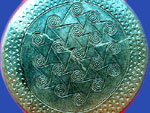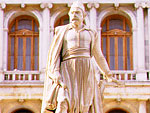History
 Excavations have brought to light different objects, many graves, ceramic vessels, statuettes, skeletons and ancient ruins dating from the Bronze Age, proving that the island has been inhabited since this period.
Excavations have brought to light different objects, many graves, ceramic vessels, statuettes, skeletons and ancient ruins dating from the Bronze Age, proving that the island has been inhabited since this period.
In the 5th century BC, the Phoenicians came and inhabited Syros and the island first rose into a commercial power as a Phoenician seaport.
In the area of Kastri and Chalandriani graves and cultivated settlements from the Early Cycladic period were found. Syros was one of the important Cycladic centres, a period during which the great Syros-Keros civilization flourished.
The 6th century BC was the century when Pherekidis, Pythagoras’ teacher, was born. He invented the heliotrope and reached the acme of his science on Syros. The cave where he used to live can be found in Ano Meria.
During the Persian wars the Persians conquered Syros which was later liberated by the Athenians. Syros became a member of the Delian League, a sea alliance created and commanded by the Athenians, and paid taxes to Athens.
In the 4th century, Syros came under the rule of Philip of Macedonia, than under the authority of its successor, Alexander the Great, and after the death of Alexander, the island, like all other the Greek islands, was under the rule of the Ptolemies of Egypt, the successors of Alexander the Great.
Like the rest of the Greek islands, Syros suffered for many centuries from pirate raids and that is why the settlements were built on hilltops, for protection.
During the Roman domination, Syros prospered and devloped for about two centuries and then declined under the shadow of its neighbour, the sacred island of Delos.
Almost nothing is known about the Byzantine period in Syros, which was of minimal importance in comparison to the greatness and grandeur of the empire.
Christianity appeared on the island during this period and Syros came under the ecclesiastical provenance of the Bishopric of Delos and then, of the Mitropolity of Athens.
The 7th and 8th century AD was a period of terrible Arab pirate raids and the appearance of the great plague.
In 1207, the Venetian took control of the Greek islands and Marco Sanudo conquered Syros and Naxos. The island of Syros became a part of the Duchy of Naxos.
During the Venetian rule, the inhabitants of Syros suffered from great poverty, hunger and pirate raids.
The Venetian influence can still be seen in the medieval town of Ano Syros, with its towering church dedicated to Saint George.
After the Venetian period the island had a significant Roman Catholic minority which came under the protection of France under the Turkish occupation.
In 1537 Syros was conquered by the Ottomans, but remained self-governed and had a favoured status.

From 1770 to 1774 the Russo-Turkish war took place and the island was won by the Russians who robbed the island during the three years of their rule. Then Syros fell again to the Turks.
It became a refuge for all the Greeks who were persecuted by the Turks, all the ones who revolted against their oppressors and those who escaped the massacres and left their devastated lands.
Those emigrants miraculously built in a few years the actual island’s capital, Ermoupolis, whose economy and culture flourished rapidly from the 19th century until the beginning of the 20th century.
It was a high period of prosperity for Syros and its inhabitants and the island was the commercial and cultural centre of Greece.
Today, Syros is the local administration centre and the capital of the Cyclades, as well as an important centre for trade, due to its fine shipyard and developed cultural life.